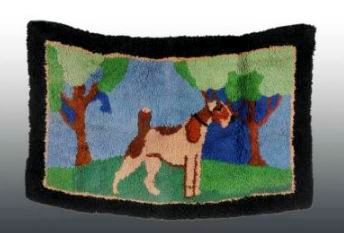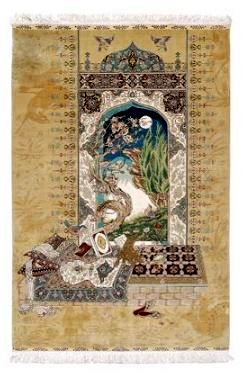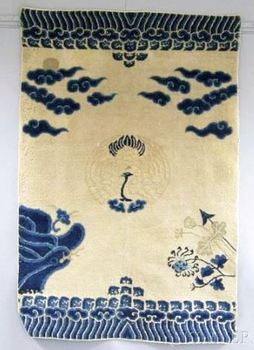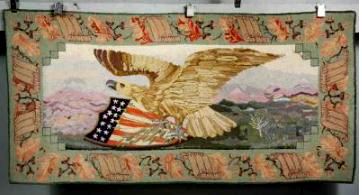ANTIQUE RUGS or ORIENTAL CARPETS
Care and Repair tips for Collectors

One day a few years ago the owner of a Persian rug in Washington, D.C., called the New York dealer she had bought it from and told him that the rug was falling apart. The dealer knew that a fine antique rug such as hers - it was a hundred-year-old Sultanabad - does not suddenly fall apart for no reason. As it turned out, the owner had placed a large plant on the corner of her prize rug. Two years later, when she picked up the plant, she found a hole two feet wide beneath it, and the surrounding area rotting. The metal water tray under the plant had been overflowing slightly - just enough to eat up two feet of carpet.
Virtually every restorer interviewed by marks4antiques.com told a similar story. The damage from plant leakage is an epidemic. We heard about one-foot holes and three-foot holes, sometimes caused by a leak, sometimes by overflow and sometimes merely by dampness. Extensive reweaving was usually necessary - a technique as old as rug weaving itself. Taking a full-time worker one month, two months or even longer, these repairs cost anywhere from $1,500 to $8,500.
There are, of course, other choices than reweaving, though purists may sneer at them and investment-oriented collectors shudder. One experienced restorer in San Francisco has accumulated many patches that he weaves into holes. The cost? Usually under $500. And he claims that this recycled older wool is better than today's and that he himself often cannot detect his own repairs.

Another plant-inflicted hole we heard of was filled by a piece cannibalized from a smaller, similar rug at a savings of thousands of dollars. And one man we know, with a gaping hole in a somewhat less prestigious rug, gladly settled for a tea-soaked piece of linen painted by an artist and set under the hole, all for around $300. The restorer, who is highly respected in the field, was proud of this inventive job.
Rug repair work can be done on many different levels - even within the same repair room. Techniques and levels of craftsmanship vary, making comparison shopping difficult. The basic problem for the rug owner and the repairer is to estimate how much the rug is worth - damaged and repaired. A repaired rug is not as valuable as a perfect one, but will certainly be more valuable than a torn one. Some repairs can virtually ruin a rug; cutting it down, for example, can reduce its value by half. Figuring out what repair technique will be appropriate may take some time and requires some research. Rug restoration can be a high art and many dealers employ full-time repairers. The repair of rugs is not taught in any school. The would-be restorer has to work as an apprentice. Rug restorers often come from the rug-making centers of the world - Turkey, Iran or Rumania. Most are women trained in rug work by their European or Near Eastern families.
It is also important to decide how much restoration is necessary. If possible, it is useful to watch demonstrations of the basic techniques and learn a few simple stitches and knots. Private non-professional restorers, to whom rug restoration is a labor of love, do occasionally turn up - even importing, cleaning, carding, spinning and dying their own wool. Not surprisingly such people are rare and their prices prohibitive. Rugs can be damaged by all sorts of things – plant leakage, moths, pets, flying embers, cigarettes, and furniture. Worn sides can open up, fray and tear. A rug in typical disrepair may have a combination of these problems, along with worn-down pile. Depending on the fineness of the weave and the size of the damages, the repairs will vary in cost.
The average repair job costs under $800, but prices may range from as little as $200 to $10,000, and it will probably take less than a month, though repair of a rare
period rug may take up to a year. Most experts suggest that rugs be cleaned professionally and checked for problems every year or two. Sometimes what looks to the
layman like a minor problem can be disastrous - or a seemingly major problem can be an easy repair. In any case, the more you do each year for your rug, the less
trouble you'll have in the end. Putting off a minor repair can be an expensive option.

Restorers can often be found working in rear rooms of dealers' showrooms amid the hundreds of rolled-up carpets. Rolls of wool in hundreds of colors, thick and fine, hang from the walls or are piled on the floor. Working on large flat tables, the restorers often use wooden frames or sticks to prop up the heavy antique rugs that sit in their laps for eight hours a day. They work with a variety of tapestry needles. The wool remaining in worn areas is scraped or cut off, and new wool is woven into the exposed mesh of the warp and woof strands that make up the rug's foundation. In both weaving and reweaving, the warp threads are vertical and are stretched out first. Horizontal rows of knots are woven onto pairs of these warp threads and then two or more woof threads are woven parallel to each horizontal row of finished knots. If a hole is formed, then the warp and woof threads must also be replaced. The warp threads are usually sewn across first to bridge the hole. But if the hole is at the edge of the rug, the far ends of the warp threads have to be attached to a small loom or knotted around nails hammered into the table. In any case, the maintenance of the right tension in the rewoven area, so that it is neither concave nor puckering, is part of the special skill of the restorer.
Most antique rugs are hand-knotted, and the knotting produces the fur-like pile. Newly knotted wool in a rewoven area has to be sheared to the right height. Cutting utensils range from animal clippers, used for rough leveling, to scissors with small curved blades, which are used when accuracy is important. There are, of course, flat-weave rugs, resembling brocade or tapestries, such as Soumaks from the Caucasus, that do not have to be sheared. After reweaving, wire or suede brushes are used to texture the repair.
The most important skill is choosing and mixing colors and matching the textures of the wool. Even with thousands of colors available, the restorer may still need another and may have to dye his own wool. But this is difficult to do properly. The ability to match colors has to be a natural talent; everything else can be learned. Everyone's eye for color is not equal. Magnificent jobs of reweaving have been irrevocably marred by inaccurate coloration.
Today, repairing rugs is a well-paying profession. Since most repairers are immigrants, they tend to settle first in New York and then to move to other parts of the country. In fact, many antique rug dealers in small cities far from New York often complain about a lack of first-rate repairers. Salaries, hence costs, are higher in New York. But rug restoration is costly everywhere and customers must be wary of a repairer's temptation to take shortcuts. The professional has to figure out how many days it will take to do the repairs, add to this cost the price of wool, utilities and rent, and then, let's say, he must triple this total cost to himself and offer the customer this price. If the rug will not be worth this amount when restored, the job is just not worth doing.
Sometimes a dealer will have an antique rug repaired only at the customer's insistence. And, many dealers who also do restoration, repair mostly their own rugs and their customers'. In most cases, two-thirds of repair work performed at a antique rugs dealer’s workshop is for his customers, who prefer to concentrate on structural repairs, such as major reweaving and fine restoration. Of course, there are larger rug restoration workshops that are able to handle more jobs.
As for choosing a restorer, it is essential that one visits the actual repair rooms. But you have to begin to understand what you are seeing. Generally, a young restorer will not know what an old woman from the old country knows. But even the old restorers have to learn new techniques. Also, it is important to ask what kind of wool is being used. The best is from England, less fine is Lebanese and the worst is American. Prices vary with the size and coarseness of the rug. Let's say you have a 9 by 12 Heriz rug that is moderately worn but without major damage. To have it washed, replied and have the edges redone would cost approximately $300. It would take three days for repiling, a couple of days for work on the edges, and three hours for washing. The best way to make the choice is to get a recommendation from someone who has used the restorer; otherwise, you should pick two or three restorers and go and visit. You can't learn anything from the Yellow Pages.
Museums or auction houses, if they recommend anyone, will automatically send you to their repairer, which doesn't necessarily mean anything. Once at the repairer's shop, ask to see rugs in stock that have been repaired, and look at these. If you can see the repair, it is no good.
As to prices, the old adage applies here - you get what you pay for. It is best to get written estimates, and also having the rug cleaned first so that the pile stands up and the colors become more identifiable. The repairer should be willing to go over the rug with the client: he sometimes circles areas of the carpet with chalk to show where work will be done and at what price.

Asking around for recommendations is far less perilous than going through the telephone book or calling museums. Watch the restorers work, if they will let you, and examine their repaired stock rugs. Be leery of anyone who wants to cut, glue, paint or use any sort of machine on the rug, and of anyone whose estimate is too low. Beware of euphemisms, such as "color restoration"; it may mean painting. If possible, check out a restorer by starting him on modest repairs on modest rugs. And if your rug is very valuable, you might make sure that your appraisals are in order and that your homeowner's insurance will cover the rug while it is off the premises.
In the end, there is no sure-fire method of choosing a restorer. Most rugs eventually need some repair work - mint-condition rugs are the exception. Each rug has its own special problems and must be treated accordingly. Properly cared for, however, a fine antique rug will outlast many generations.
How to care for antique rugs
• Do not vacuum your rug every day. Once a week is enough. A carpet sweeper is even better than a vacuum cleaner: it causes less wear.
• Turn your rug around once a year so that it gets even wear and even light.
• Though rugs are unlikely to be attacked by moths or other insects if used daily and kept clean (regular vacuuming of both sides of a rug will get rid of
destructive larvae), rugs can be mothproofed professionally or at home. Use mothballs if the rug is being stored or left in an unoccupied home.
• Do not try to repair a rug yourself. A few collectors of antique rugs have made a hobby of doing some basic repairs themselves - but they know their
limitations.
• Cleaning rugs in the snow or beating them with a flat beater are the good, old-fashioned methods, but not very practical for city dwellers. However, you
can turn small rugs upside down and rub their backs with a vacuum nozzle to knock out embedded dirt.
• Have your rug professionally cleaned once every year or two - unless it is small enough to be washed at home in cold water and a mild soap made especially
for wools. Never have your rug dry-cleaned.
• Always use an underpad, and lay your rug on an even floor.
• Live with your rug. Use your rug. Most fine old hand-made rugs are resilient. Rugs fade gracefully and age with dignity and individuality, and friction of
use gives a rug a beautiful sheen. The more you use it, the better it looks, until it begins to wear down. Thus tears, holes and unraveled selvages are not graceful
"signs of age."
Unlock the true value
of your collection with our comprehensive research guides from identifying makers' marks to appraising all kinds of
antiques and collectibles.
Our up-to-date information will give you an accurate understanding of your items' worth. Don't miss out on this
valuable resource - visit our research tools today!
Search our price guide for your
own treasures





